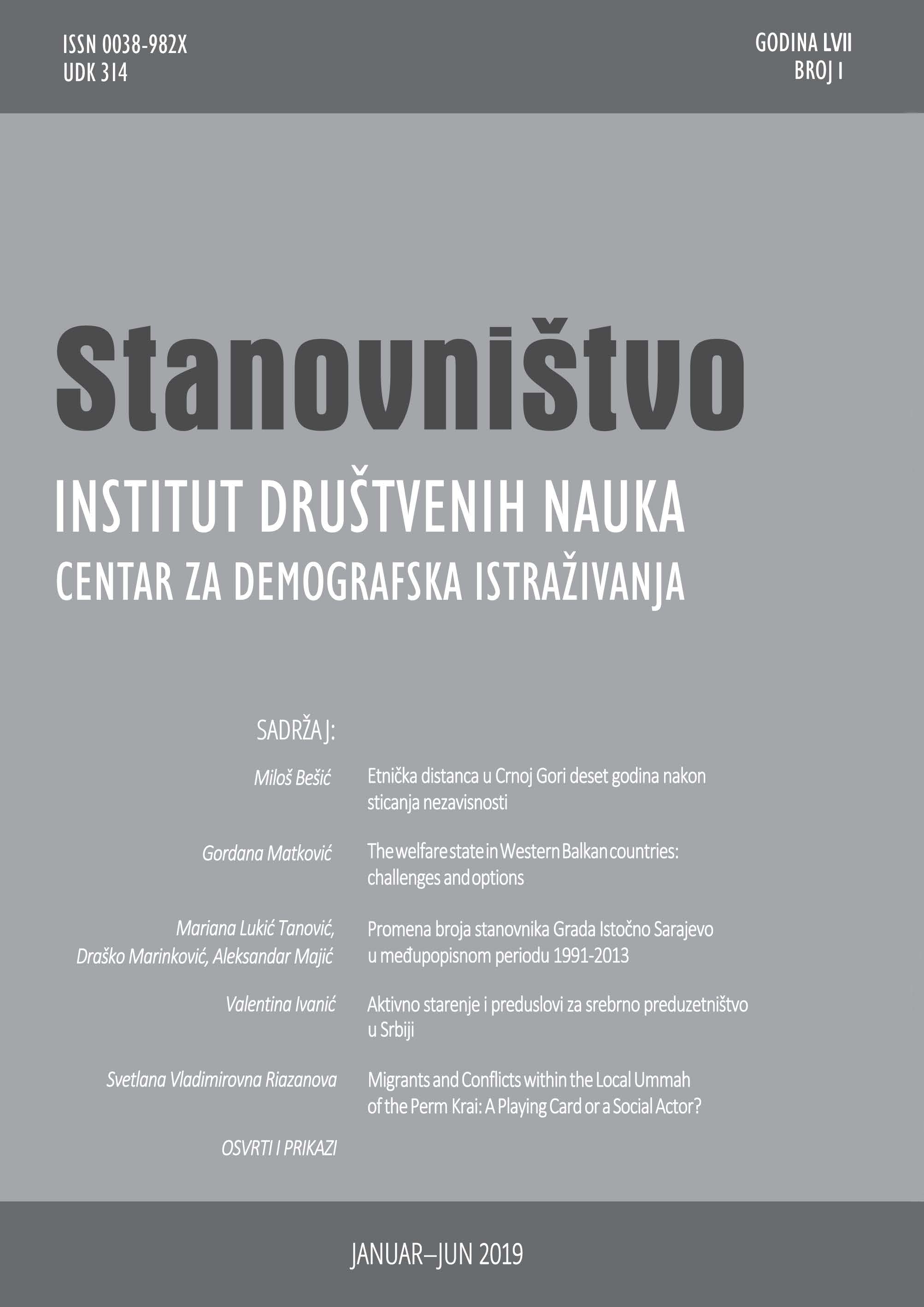Etnička distanca u Crnoj Gori deset godina nakon sticanja nezavisnosti
Glavni sadržaj članka
Apstrakt
U ovom radu prezentiramo rezultate longitudinalnog istraživanja etničke distance u Crnoj Gori. Osnovni cilj istraživanja bio je da se utvrde promene stepena međuetničkog distanciranja koje su nastale od 2013. do 2018. godine. Pretpostavke na kojima počiva merenje razlika u etničkom distanciranju tiču se snažnih promena u pogledu ukupne političke konstelacije i delovanja političkih faktora na međuetničku distancu. Podaci ukazuju da je u ovom periodu porastao nivo međuetničkog i ukupnog etničkog distanciranja, što posledično u multietničkoj državi predstavlja izvor potencijalne ukupne političke nestabilnosti. Povećanje stepena međuetničkog distanciranja merimo gotovo u svim aspektima, a naročito kada je reč o distanci koju iskazuju Albanci prema drugim etničkim skupinama. Metodološki, u istraživanjima je korišćena ekstenzivna Bogardusova skala za istraživanje socijalne distance. Kada je o samom merenju reč, rad se oslanja na analize trenda i regresione metode, kako bi se obezbedila preciznost merenja efekta protoka vremena na porast etničkog distanciranja. Konačno, rad kritički preispituje moguće faktore identifikovanih trendova rasta etničke distance.
Preuzimanja
Detalji članka
Centar za demografska istraživanja Instituta društvenih nauka
Reference
Bešić, M. (2001). Nacija i nacionalizam u svetlu društvene transformacije real-socijalizma. U B. Đukanović, B. Kuzmanović, M. Lazić i M. Bešić (ur.), Nacija i država (str. 39-64). Podgorica: CID.
Bešić, M. (2005). National versus Civic Option in Montenegro. In D. Vujadinović, L. Veljak, V. Goati, V. Pavićević (Eds.), Between authoritarianism and democracy: Serbia, Montenegro, Croatia, II. Civil society and political culture (pp. 217-232). Beograd: Cedet.
Bešić, M., & Spasojević, D. (2018). Montenegro, NATO and the divided society. Communist and Post-Communist Studies, 51(2), 139-150.
Bieber, F. (2003). Montenegro in transition. Problems of Identity and Statehood. Baden-Baden: Nomos.
Bogardus, E. S. (1925). Measuring social distance. Journal of applied sociology, 9, 299-308.
Clark, A., Hocevar, D., & Dembo, M. H. (1980). The role of cognitive development in children's explanations and preferences for skin color. Developmental Psychology, 16(4), 332-339.
Colletta, N. J., & Cullen, M. L. (2000). Violent conflict and the transformation of social capital: lessons from Cambodia, Rwanda, Guatemala, and Somalia (English). Washington, D.C.: The World Bank. http://documents.worldbank.org/curated/en/799651468760532921/Violent-conflict-and-the-transformation-of-social-capital-lessons-from-Cambodia-Rwanda-Guatemala-and-Somalia
Collier, P. (2001). Implications of ethnic diversity. Economic policy, 16(32), 128-166.
Deutsch, K. W. (1966). Nationalism and social communication. An Inquiry into the Foundations of Nationality (2nd ed.). Cambridge, MA: MIT Press
DeVos, G. A. (1990). Self in society: A multilevel, psychocultural analysis. In M. M. Suárez-Orozco (ed.), Status inequality: The self in culture (pp. 17-74). Newbury Park, CA: Sage Publications.
Fearon, J. D. (1999). Why ethnic politics and ‘pork’ tend to go together. Paper presented at SSRC-MacArthur sponsored conference on “Ethnic Politics and Democratic Stability”. Chicago: University of Chicago.
Hello, E., Scheepers, P., & Sleegers, P. (2006). Why the more educated are less inclined to keep ethnic distance: An empirical test of four explanations. Ethnic and Racial Studies, 29(5), 959-985.
Jovanović, J. (1947). Stvaranje crnogorske države i razvoj crnogorske nacionalnosti: istorija Crne Gore od početka VIII vijeka do 1918 godine. Cetinje: Obod.
Keiichi, K. (2007). The issue of independence and ethnic identity in Montenegro. Southeastern Europe, 32(1), 163-180.
Komar, O., & Živković, S. (2016). Montenegro: A democracy without alternations. East European Politics and Societies, 30(4), 785-804.
MONSTAT (2019). Tabela CG1: Stanovništvo prema starosti i nacionalnoj odnosno etničkoj pripadnosti. Popis stanovništva, domaćinstava i stanova u 2011. godini. Podgorica: Uprava za statistiku Crne Gore – MONSTAT. https://www.monstat.org/cg/page.php?id=534&pageid=322 (pristupljeno 25.01.2019.)
Olzak, S. (1992). The dynamics of ethnic competition and conflict. Stanford, CA: Stanford University Press.
Smith, E. J. (1991). Ethnic identity development: Toward the development of a theory within the context of majority/minority status. Journal of Counseling & Development, 70(1), 181-188.
Tajfel, H. (1978). Interindividual behaviour and intergroup behaviour. In H. Tajfel (ed.), Differentiation between social groups: Studies in the social psychology of intergroup relations (pp. 27-60). Oxford, England: Academic Press.
Troch, P. (2014). From “And” to “Either/or” Nationhood in Montenegro during the Yugoslav Twentieth Century. East European Politics and Societies, 28(1), 25-48.
Tuathail, G. Ó., & Dahlman, C. (2006). Post-domicide Bosnia and Herzegovina: Homes, homelands and one million returns. International Peacekeeping, 13(2), 242-260.





